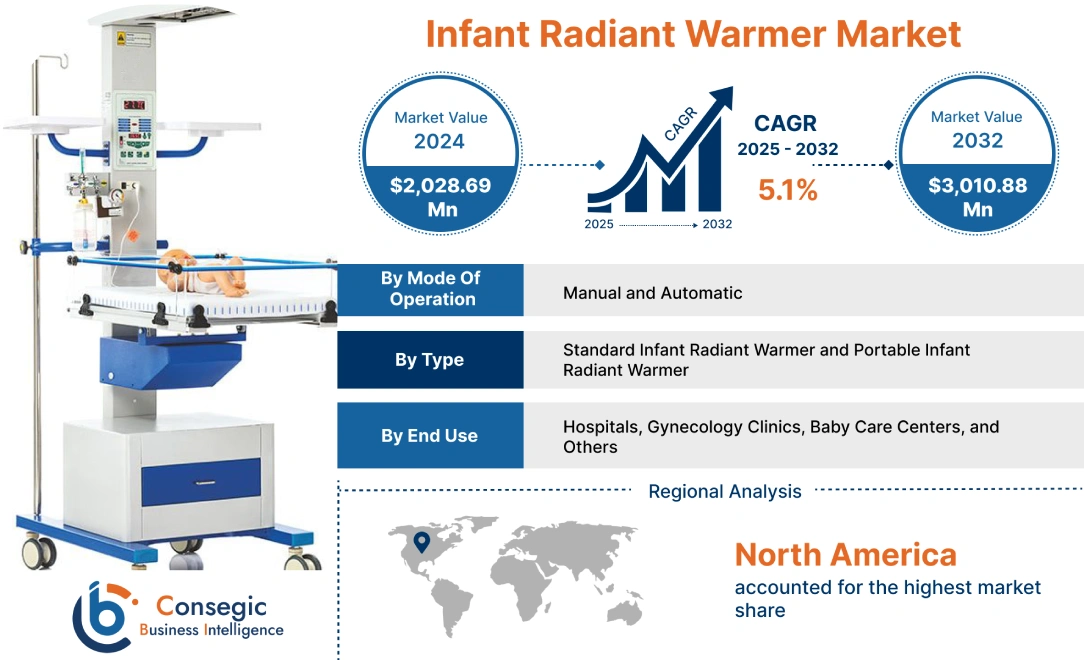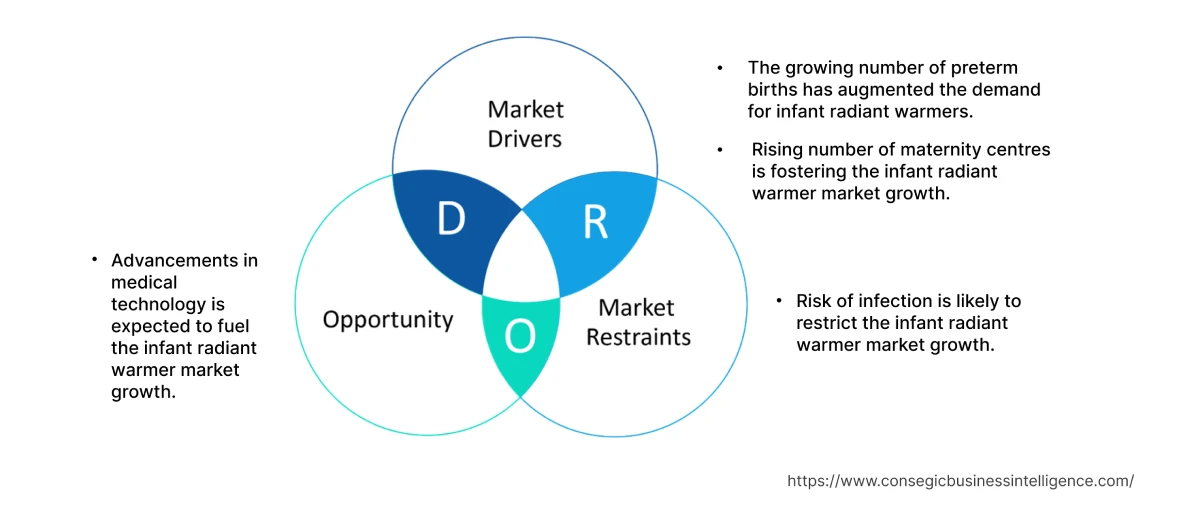- Summary
- Table Of Content
- Methodology
Infant Radiant Warmer Market Size :
Consegic Business Intelligence analyzes that the Infant Radiant Warmer Market size is estimated to reach over USD 3,010.88 Million by 2032 from a value of USD 2,028.69 Million in 2024 and is projected to grow by USD 2,095.19 Million in 2025, growing at a CAGR of 5.10% from 2025 to 2032.
Infant Radiant Warmer Market Scope & Overview:
An infant radiant warmer is a medical device that uses radiant heat to maintain the body temperature of newborn infants. It is typically used in hospitals for premature babies or infants who are at risk of hypothermia. Hypothermia is a serious condition that can be fatal for premature babies. It helps to prevent hypothermia by providing a warm environment for premature babies. It has evolved over the years to incorporate advanced features such as integrated sensors for temperature control, alarms for temperature fluctuations, and others. Its market has witnessed growth due to increasing awareness of neonatal care, improvements in healthcare infrastructure, and the rising number of preterm births.
Infant Radiant Warmer Market Insights :
Key Drivers :
The growing number of preterm births Fuels the Market Progress
Preterm births can lead to various health challenges, including underdeveloped lungs and difficulties regulating body temperatures. Infant radiant warmers help address these issues by providing a controlled environment with a warm surface and heat source, allowing healthcare providers to monitor and regulate the baby's temperature more effectively. Analysis of market trends concludes that the rise of premature births across the globe is one of the major factors that is positively impacting the adoption of radiant warmers. For instance, according to the report published by Tommy's, across the UK, there were around 53,000 babies born prematurely in 2021, an increase of 7.4% from the previous year.
Rising number of maternity centres Boosts the Market Development
Infant radiant warmers are essential pieces of equipment in neonatal care, as they help to maintain the body temperature of newborn infants. This is especially important for premature babies, who are more likely to lose heat than full-term babies. The growing awareness regarding the importance of neonatal care has led to a significant increase in the number of birthing and maternity centres. For instance, according to the statistics published by the March of Dimes, from 2020 to 2021, the number of birth centres in the U.S. almost doubled to over 400. Analysis of market trends concludes that the growing prevalence of maternity care centres has surged the infant radiant warmer market demand.
Key Restraints :
Risk of infections Hampers the Market Development
The risk of infection is a major concern in the use of infant radiant warmers. These devices use radiant heat to warm newborn infants, and this heat can create an environment that is conducive to the development of bacteria. Further, infections caused by bacteria are one of the leading causes of neonatal death. The neonatal period is the most vulnerable time for a child's survival. According to the statistics reported by UNICEF, globally, 2.3 million children died in the first month of life in 2021, approximately 6,400 neonatal deaths every day. Analysis of market trends concludes that the high neonatal mortality rate is likely to hamper the demand for the radiant warmers.
Future Opportunities :
Advancements in medical technology will emerge as one of the key opportunities that fuels the infant radiant warmer market growth
The rising awareness related to the specialized care of newborns has increased the demand for advanced medical technologies, equipment, and skilled professionals working in healthcare industry to cater to the need of premature or ill infants. Advancements include the development of new and improved radiant warmers that are more efficient, safer, and easier to use. As infant radiant warmers are essential pieces of equipment in neonatal care, their demand will aid in surging the market growth during the forecast period. Analysis of market trends concludes that advancements in medical technology are emerging as one of many infant radiant warmer market opportunities that will drive market expansion.
Infant Radiant Warmer Market Report Insights :
| Report Attributes | Report Details |
| Study Timeline | 2019-2032 |
| Market Size in 2032 | USD 3,010.88 Million |
| CAGR (2025-2032) | 5.1% |
| By Type | Standard Infant Radiant Warmer and Portable Infant Radiant Warmer |
| By Mode of Operation | Manual and Automatic |
| By End Use | Hospitals, Gynecology Clinics, Baby Care Centers, and Others |
| By Region | North America, Europe, Asia Pacific, Latin America, and Middle East & Africa |
| Key Players | SS TECHNOMED (P) LTD., Avante, GE HealthCare, Advin Health Care, Apothecaries Sundries Mfg. Pvt. Ltd., Drägerwerk AG & Co. KGaA, GPC Medical Ltd., and nice Neotech Medical Systems Pvt. Ltd. |
Infant Radiant Warmer Market Segmental Analysis :
By Type :
The type segment is categorized into standard and portable products. In 2024, the the standard segment accounted for the highest infant radiant warmer market share. A standard radiant warmer typically offers better temperature control, stability, and features, making it suitable for hospitals or facilities in healthcare industry where precise temperature regulation is essential. Standard radiant warmers are predominantly used for their ability to provide ease of access to medical professionals due to their ergonomics design. Standard warmers are a much more cost-effective solution, this leads to their increased use in hospitals, baby care centers and other facilities. Therefore, the increasing number of healthcare facilities is a prominent factor that is boosting the segment demand.
However, the portable radiant warmer segment is expected to grow at the fastest CAGR in the market during the forecast period. They can be easily moved from one location to another and can also be helpful for home healthcare providers who need to move infants to different places. They can be used to increase to efficiency of treating newborn babies as they facilitate transport of babies from different departments to carry out medical procedures. The usage of a portable warmer can allow parents to have easier of access to the baby for frequent parent interaction, thus aiding to the well-being of the infant. Moreover, the growth of the segment is attributed to the rising focus on improving the efficiency, precision, and safety of radiant warmers devices.
By Mode of Operation :
The mode of operation segment is categorized into manual and automatic. In 2024, the manual segment accounted for the highest market share. Manually operated radiant warmers are typically less expensive than automatic radiant warmers. These devices are also more portable, as they do not require an electrical outlet to operate. Their simple operation also allows freshly trained medical professionals to utilize it with ease for carrying out medical procedures on an infant. Analysis of market trends concludes that the manual warmers are less prone to malfunction due to its simplicity design and operation, thus leading to their increased usage in emergency situations. Manual warmers allow doctors to adjust its temperatures as per the medical procedures need. Hence, the aforementioned benefits are driving the demand for manual radiant warmers.
However, the automatic segment is expected to grow at the fastest CAGR in the overall infant radiant warmer market. The growth of the segment is attributed to an increase in accuracy and consistency along with ease of use. The automatic warmers contain alarms that can make medical staff aware of its real time temperature, this allows for efficient monitoring of baby's health condition. The alarms in the automatic warmers can also be used to take swift response in care of a medical emergency. Automatic warmers also provide features like precise temperature control, improved stability thus leading to its increased use in healthcare clinics and hospitals. As a result of these advantages, automatic radiant warmers are becoming the standard of care for many hospitals and clinics.
By End-User :
The end use segment is categorized into hospitals, gynecology clinics, baby care centers, and others. In 2024, the hospitals segment accounted for the highest market share of 45.50% in the overall infant radiant warmer market. Infant radiant warmers are an important tool for providing care for newborn infants in hospitals. The growth of the segment is attributed to the growing government initiatives in the healthcare industry. Governments are working to improve the quality of healthcare by introducing accreditation standards for hospitals and clinics. Additionally, the radiant warmers are being increasingly utilized in hospitals for their ability to provide continuous thermoregulation for newborns with health complications. Their ability to be used in a variety of situations like a pregnancy delivery room to stabilize infants born prematurely or with life threatening health conditions like hypothermia makes them an important solution to be used in the hospitals, therefore leading to the dominance of the segment.
Further, the baby care centers segment is expected to grow at the fastest CAGR in the market during the forecast period. Baby care centers are staffed by qualified professionals who are trained to care for infants. Moreover, the growing requirement for quality childcare will increase the use of radiant warmers in baby care centers. The radiant warmers allow the center professionals to easily access the baby for medical examinations and routine checkups, thus leading to their increased usage in baby care centers. Moreover, the growing number of baby care centers in developing countries is another influencing factor likely to foster segment growth in the forecast years.
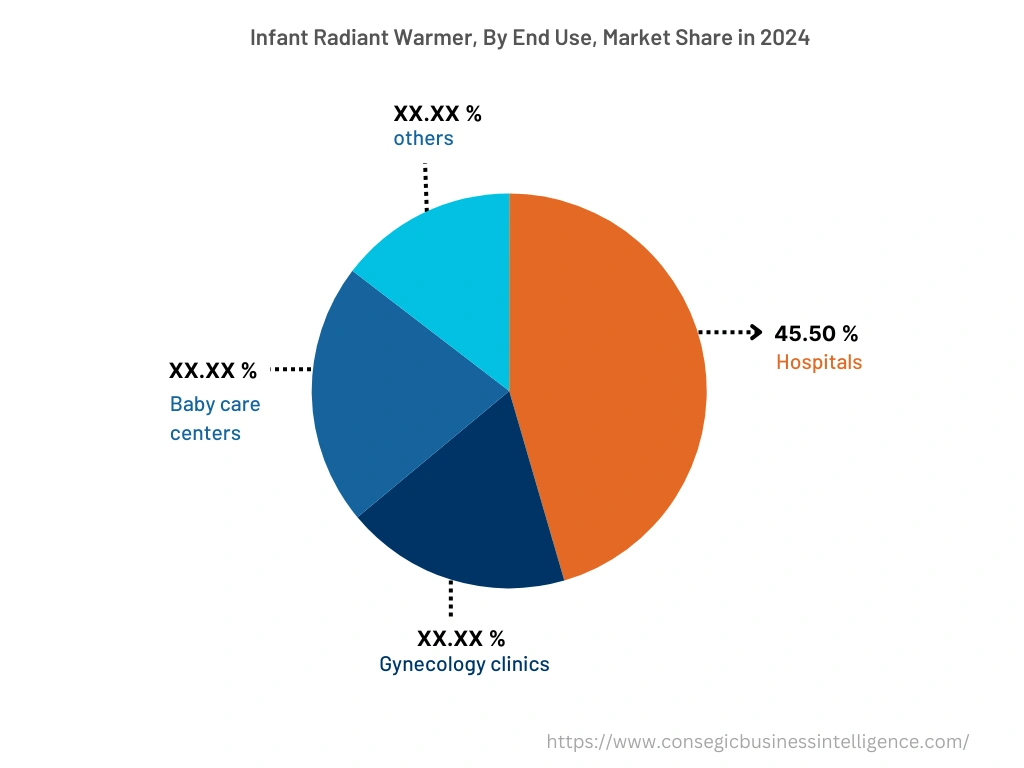
By Region :
The regional segment includes North America, Europe, Asia Pacific, the Middle East and Africa, and Latin America.
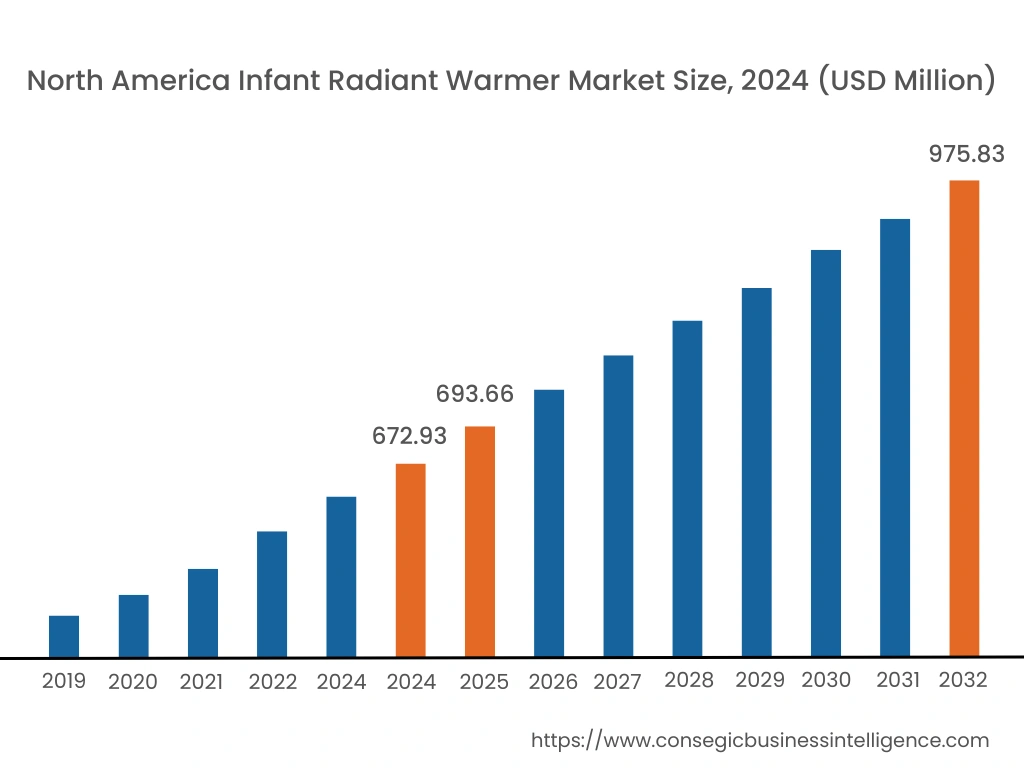
North America is estimated to reach over USD 975.83 Million by 2032 from a value of USD 672.93 Million in 2024 and is projected to grow by USD 693.66 Million in 2025. Analysis of market trends concludes that in North American region, the U.S. accounted for the highest market share of 65.30% during the base year 2024 owing to the increasing government initiatives and growing focus on child survival research. For instance, according to the report published by KFF, the U.S. government has adopted a longer-term goal of ending preventable child and maternal deaths by 2035. Further, the increase in government funding for Maternal & Child Health (MCH) is also contributing to the infant radiant warmer market growth in the region.
Moreover, Asia Pacific is expected to grow at the fastest CAGR of 5.6% during the forecast period. The Asia Pacific region is home to several large and growing economies, such as China, India, and Japan. Analysis of infant radiant warmer market trends concludes that these economies are experiencing rapid urbanization and economic development, leading to an increase in the demand for healthcare services. In addition, the Asia Pacific region has a large population of newborns. For instance, according to the statistics published by the World Health Organization (WHO), in 2020, there were over 40 million births in Asia Pacific out of which, about 10 million were preterm. Analysis of market trends concludes that the high prevalence of preterm babies in the region cause market expansion over the forecast period.
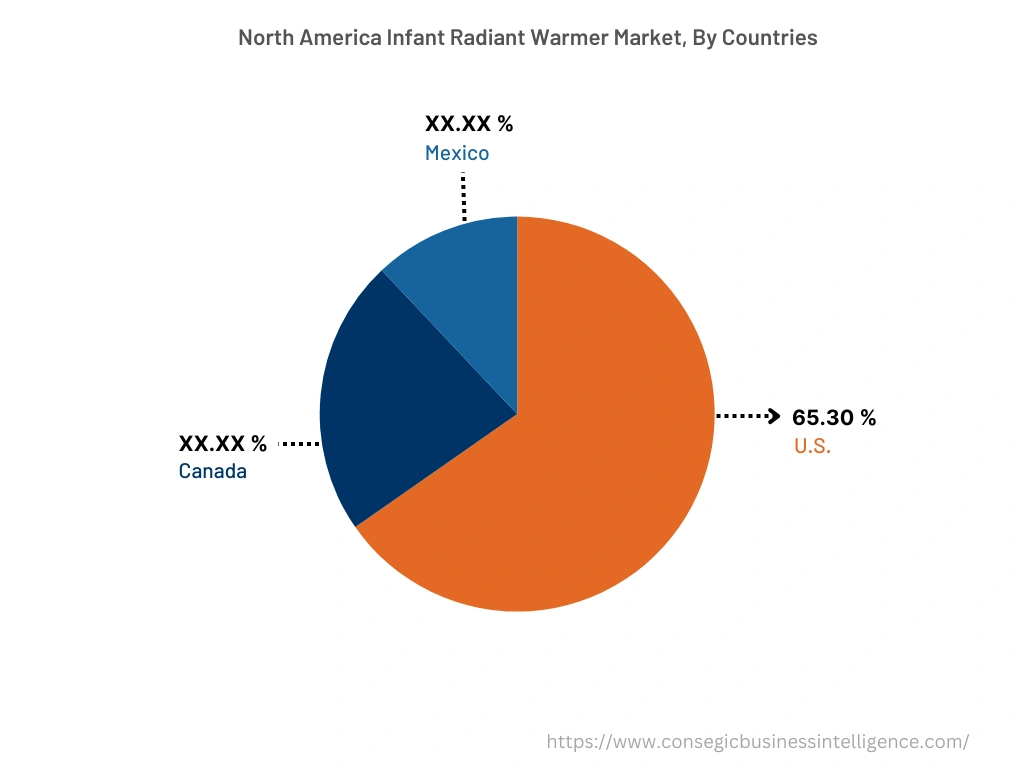
Top Key Players & Market Share Insights:
The infant radiant warmer market is highly competitive, with several large players and numerous small and medium-sized enterprises. The major companies operating in the infant radiant warmer industry have strong research and development capabilities and a strong presence in the market through their extensive product portfolios and distribution networks. The infant radiant warmer market analysis concluded that market is characterized by intense competition, with companies focusing on expanding their product offerings and increasing their market share through mergers, acquisitions, and partnerships. The key players in the market include-
- SS TECHNOMED (P) LTD.
- Avante
- GPC Medical Ltd.
- nice Neotech Medical Systems Pvt. Ltd.
- GE HealthCare
- Advin Health Care
- Apothecaries Sundries Mfg. Pvt. Ltd.
- Dragerwerk AG & Co. KGaA
Key Questions Answered in the Report
What was the market size of the infant radiant warmer market in 2024? +
In 2024, the market size of infant radiant warmer was USD 2,028.69 million.
What will be the potential market valuation for the infant radiant warmer market by 2032? +
In 2032, the market size of infant radiant warmer is expected to reach USD 3,010.88 million.
What are the key factors driving the growth of the infant radiant warmer market? +
The rising incidence of preterm births is accelerating the infant radiant warmer market growth.
What is the dominating segment in the infant radiant warmer market by mode of operation? +
In 2024, the manual segment accounted for the highest market share in the overall infant radiant warmer market.
Based on current market trends and future predictions, which geographical region will have the fastest impact on the infant radiant warmer market's growth in the coming years? +
Asia Pacific is expected to be the fastest-growing region in the market during the forecast period.
